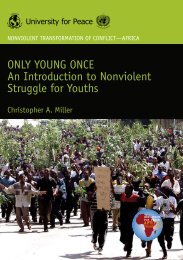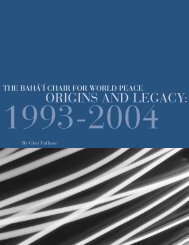IntroductionWHILE <strong>in</strong> the Sudan protracted <strong>conflict</strong> seems to be head<strong>in</strong>g towards the end<strong>of</strong> one <strong>of</strong> its major manifestations, the bloody war <strong>in</strong> the South, anotherequally murderous and dehumanis<strong>in</strong>g <strong>conflict</strong> erupts <strong>in</strong> Darfur. In spite <strong>of</strong>the numerous social, cultural, economic and political differences which characterisethe two regions, they still share many <strong>of</strong> the root <strong>cause</strong>s that are beh<strong>in</strong>d each <strong>of</strong>the <strong>conflict</strong> situations.While the deeply entrenched <strong>cause</strong>s affect other regions <strong>of</strong> the country <strong>as</strong> theydid <strong>in</strong> the South or now <strong>in</strong> Darfur, the particularity <strong>of</strong> each sub-<strong>conflict</strong> e.g. theE<strong>as</strong>t, is <strong>in</strong>cumbent on root-<strong>cause</strong>s particular to the region and other vary<strong>in</strong>g secondaryor <strong>in</strong>cidental <strong>cause</strong>s. In analys<strong>in</strong>g the <strong>conflict</strong>s <strong>in</strong> the Sudan, due considerationneeds to be given also to structural <strong>as</strong> well <strong>as</strong> external factors, namely theimpact <strong>of</strong> the global <strong>conflict</strong> system, and <strong>as</strong> we argue, systems.Academic research <strong>as</strong> well <strong>as</strong> practical politics did not fail to identify the obviousrelationships and l<strong>in</strong>kages that justified describ<strong>in</strong>g or group<strong>in</strong>g adjacent national<strong>conflict</strong>s <strong>in</strong>to a regional or sub-regional <strong>conflict</strong> system. The progressive departurefrom the cl<strong>as</strong>sic perception <strong>of</strong> <strong>conflict</strong> <strong>as</strong> be<strong>in</strong>g either <strong>in</strong>ternal or external resulted<strong>in</strong> abandon<strong>in</strong>g the dichotomous approach developed by the advocates <strong>of</strong> the RealistDoctr<strong>in</strong>e <strong>of</strong> <strong>in</strong>ternational relations. In Africa, arbitrary boarders that split <strong>in</strong>digenouspopulations between states <strong>in</strong>evitably blurred the <strong>in</strong>ternal nature <strong>of</strong> <strong>conflict</strong>sand justified the <strong>in</strong>tervention <strong>of</strong> the co-host <strong>of</strong> the same ethnic group, <strong>in</strong> c<strong>as</strong>e <strong>of</strong><strong>in</strong>volvement <strong>in</strong> disputes or <strong>conflict</strong>s.The notion that <strong>conflict</strong>s with<strong>in</strong> a state’s boundaries are strictly a domesticaffair holds no water and is no longer acceptable to regional organisations [AU] orthe <strong>in</strong>ternational community at large. Scholars who resent vehemently ‘<strong>in</strong>ternationalisation’<strong>of</strong> <strong>conflict</strong>s are to realise that though they are progressively depriv<strong>in</strong>g<strong>in</strong>dividual governments <strong>of</strong> absolute authority and control, that they are render<strong>in</strong>gthem entirely visible. Conflict analysis precedes <strong>conflict</strong> management. The methodology,approach and techniques <strong>of</strong> management depend, among other th<strong>in</strong>gs, onthe characteristics and l<strong>in</strong>kages <strong>of</strong> the overall <strong>conflict</strong> system. Resolv<strong>in</strong>g a <strong>conflict</strong><strong>in</strong> the absence <strong>of</strong> those considerations is virtually futile.The Sudan <strong>conflict</strong> is <strong>in</strong>tegrally <strong>in</strong>cluded <strong>in</strong> the Horn <strong>of</strong> Africa <strong>conflict</strong> system.The <strong>in</strong>terl<strong>in</strong>kages and shared <strong>cause</strong>s and sub-processes are evident. The Horn <strong>of</strong>Africa <strong>conflict</strong> system <strong>in</strong>cludes Somalia, Ethiopia, Eritrea, Djibouti and some would<strong>in</strong>clude Kenya and Uganda. To relate the Darfur <strong>conflict</strong> sub-system to the globalSudan crises and <strong>conflict</strong> system is the first step towards understand<strong>in</strong>g the impactthe Horn and other <strong>conflict</strong> systems have on Darfur. Sudan is <strong>in</strong>cluded <strong>in</strong> anotherAfrican <strong>conflict</strong>s system namely the Greater Lakes <strong>conflict</strong> system. The <strong>in</strong>terl<strong>in</strong>kages,shared <strong>cause</strong>s and direct impact on the war <strong>in</strong> the South are obvious. The82
many <strong>in</strong>terventions that took place <strong>in</strong> or for Sudan exemplify those l<strong>in</strong>ks.The Greater Lakes <strong>conflict</strong> system <strong>in</strong>cludes <strong>as</strong> far <strong>as</strong> its front vis-à-vis the Sudana northern flank, namely Uganda, Kenya, the Democratic Republic <strong>of</strong> Congo (DRC)and Rwanda. Through the <strong>in</strong>termediary <strong>of</strong> the Central African Republic (CAR) and<strong>in</strong>ternally the State <strong>of</strong> West Bahr El Gazal, the Lakes <strong>conflict</strong> system tentacles managedto reach Darfur.Trac<strong>in</strong>g the orig<strong>in</strong>s <strong>of</strong> the Darfur <strong>conflict</strong> requires <strong>in</strong>vestigat<strong>in</strong>g the historic,social, cultural, economic and ethnic <strong>as</strong>pects <strong>of</strong> the <strong>conflict</strong> that would reveal froma Darfurian standpo<strong>in</strong>t, and perspective, the nature and extent and effect <strong>of</strong> theexternal factors. The geographical, natural and ecological traits <strong>of</strong> Darfur reveal thenature and importance <strong>of</strong> those factors. They form primordial l<strong>in</strong>kages, especiallywith the Chadian <strong>conflict</strong> system. Analys<strong>in</strong>g <strong>in</strong> detail the relations that b<strong>in</strong>d Darfurto Chad expla<strong>in</strong>s an important dimension <strong>of</strong> the Darfur crisis.The contemporary <strong>as</strong>pect <strong>of</strong> those relations is essential. The historic <strong>as</strong>pect isequally tell<strong>in</strong>g and it shows how sheer ignorance and or a policy <strong>of</strong> deliberateconcealment and deception resulted <strong>in</strong> los<strong>in</strong>g many an opportunity, and led to theunprecedented aggravation <strong>of</strong> the horrors and suffer<strong>in</strong>g. The reciprocal impact<strong>in</strong>geffect <strong>of</strong> the relationship between the Chadian <strong>conflict</strong> and the Darfur <strong>conflict</strong>shaped the modern day state <strong>of</strong> affairs <strong>in</strong> both regions. This is to be considered<strong>as</strong> a cont<strong>in</strong>ual <strong>cause</strong> for alarm s<strong>in</strong>ce significant political change <strong>in</strong> Chad is always<strong>in</strong>stigated, orig<strong>in</strong>ated and led from Darfur. Change <strong>of</strong> regimes <strong>in</strong> Chad s<strong>in</strong>ce Tombalbayeto the current president Deby, p<strong>as</strong>s<strong>in</strong>g by Maloum, Oueddi, and Habre all cameto power through Darfurian <strong>in</strong>termediaries and were fatally weakened and toppledthrough the same.The role <strong>of</strong> Libya is tremendous <strong>as</strong> far <strong>as</strong> the relationship between Sudan andChad is concerned. The Libyans learned the lesson that the fate <strong>of</strong> Chad is determ<strong>in</strong>ed<strong>in</strong> Darfur. Trac<strong>in</strong>g the brutal Libyan/Chadian encounter with its emotional,political and military remnants necessitates <strong>in</strong>tensify<strong>in</strong>g the search for global solutions.Border disputes between the Central African Republic and Sudan do not call formuch alarm, none the less CAR’s own <strong>conflict</strong>s spill over <strong>in</strong>to Chad and the Sudanand will eventually add more trouble to Darfur. Armed banditry, illicit smallarmstrade, drug traffick<strong>in</strong>g etc. will be dealt with effectively if candid authorities cooperate.Is another <strong>conflict</strong> system that <strong>in</strong>cludes CAR, Chad, Sudan and Libya <strong>in</strong> themak<strong>in</strong>g and who else does it <strong>in</strong>clude? Are states like Niger, Cameroon and DRC part<strong>of</strong> this system and why? And where does the epicentre <strong>of</strong> this system exist? Is it,given the shift<strong>in</strong>g nature <strong>of</strong> epicentres, now <strong>in</strong> Darfur?83
- Page 1:
ENVIRONMENTAL DEGRADATIONAS A CAUSE
- Page 4 and 5:
Cover Photo:AU forces patrol Darfur
- Page 7 and 8:
PREFACEThese essays were originally
- Page 9 and 10:
AcknowledgementsThe conference was
- Page 11 and 12:
Executive SummaryByMary E. King and
- Page 13 and 14:
the theme of the conference, outlin
- Page 15 and 16:
• The question of warrior culture
- Page 17 and 18:
Deryke Belshaw, University of East
- Page 19 and 20:
area in West Darfur of 1.5m feddans
- Page 21 and 22:
on the interaction between conflict
- Page 23 and 24:
Conflict In DarfurHistorical andCon
- Page 25 and 26:
distributive centre and where the r
- Page 28 and 29:
sues quite separate. Evidence for t
- Page 30 and 31:
FOOTNOTES1It is not my purpose here
- Page 32 and 33: 20On other emerging ethnically-base
- Page 34 and 35: IntroductionTHE Greater Darfur regi
- Page 36 and 37: 2. Agriculture (Farming)Crop farmin
- Page 38 and 39: Secondly, the demand for mutton and
- Page 40 and 41: groundnut and sesame as sources of
- Page 42 and 43: The situation of drinking water in
- Page 44 and 45: ReferencesConference, Meleet, North
- Page 46 and 47: IntroductionTHE residents of the Um
- Page 48 and 49: Phase Two:This phase was a monitori
- Page 50 and 51: zone southward — and to use these
- Page 52 and 53: • Some water points in places lik
- Page 54 and 55: This study and the seminar organize
- Page 57 and 58: Land Tenure,Land Use andConflicts i
- Page 59 and 60: tain innovations called hakura (pl.
- Page 61 and 62: mands for food production. All thes
- Page 63 and 64: Hashab Tenure SystemHashab ownershi
- Page 65 and 66: co-exist at the local level where e
- Page 67 and 68: IndigenousInstitutions andPractices
- Page 69 and 70: abs. In the past they had been invo
- Page 71 and 72: Sufi OrderSufi orders are religious
- Page 73 and 74: Native Administration, i.e. Tribal
- Page 75 and 76: Rizayqat homeland is at the extreme
- Page 77 and 78: esearchers and statesmen. A bigger
- Page 79: ReferencesBakheit, Jaafar M.Ali. 19
- Page 84 and 85: ReferencesHarir, S. 1993. ‘Arab B
- Page 86 and 87: IntroductionTHE Darfur Region lies
- Page 88 and 89: Table (1)Water program for Darfur 2
- Page 90 and 91: anging from 150mm the north and 450
- Page 92 and 93: ReferencesIbrahim, Abdel Rahman Abb
- Page 94 and 95: CONCLUSIONTHE collection of papers
- Page 96 and 97: GLOSSARYAjawidArdaBaqqaraDarDukhnFa
- Page 99 and 100: A Darfur Timeline99
- Page 101 and 102: 1898 On the eve of the battle of Om
- Page 103 and 104: Bibliography103
- Page 105 and 106: El Mahdi S. Mohamed. 1979. Introduc
- Page 107 and 108: Tothill, J.D. 1948. Agriculture in
- Page 109 and 110: Biographical Sketch: Rex Sean O’F
- Page 111 and 112: 111











